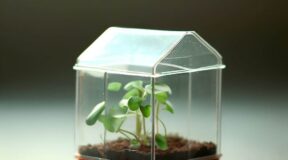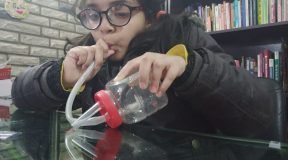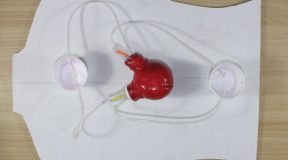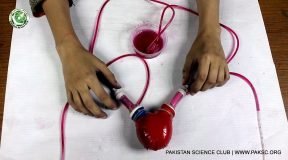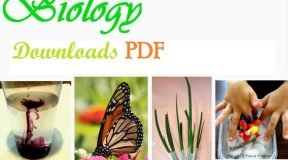Biology Experiment Geotropism in Radicles. The response of radicles to unilateral gravity
reparation
Outline Pea seedlings with straight radicles are pinned in two containers so that the radicles are horizontal. One container is rotated on a clinostat.
Advance preparation and materials
Seedlings. Three or four days before the experiment soak the peas overnight and on the following day roll them up in moist blotting paper or newsprint with the radicles pointing downwards as described on p. 2.01 and p. 03. Place the rolls in plastic bags and examine them after day 2 and day 3. If the radicles reach 20 mm or more put the rolls in the refrigerator until required. Radicles about 25 mm long are the best material for this experiment. (100 peas weigh about 25 g.)
Clinostat. Use a spirit marker to put numbers on the turntable so that each group can identify its seedlings. Line the plastic cover with moist blotting paper or paper towels to maintain high humidity and to exclude directional light.
A similar container will be needed for the experiment. A plastic sandwich box with a piece of expanded polystyrene or pin board wedged in the bottom is effective. Put numbers on the board but confine them to that part of the board which will be highest when the box is on its side, to prevent the radicles reaching the lower side of the box when they grow downwards. Line the box with moist blotting paper or paper towels.
Apparatus - per class - per group
clinostat and container for rotated seedlings 2 pins (entomological or other rustless pins) suitable container for stationary seedlings 1 ruler with mm
NOTE. (a) Keep both the clinostat and the sandwich box away from windows and direct sunlight or other sources of heat and examine them each day to ensure they are kept thoroughly moist.
(b) If a clinostat is not available, experiment 7 offers an alternative for showing geotropism of radicles. The response of radicles to unilateral gravity You are provided with two pea seedlings with fairly straight radicles.
(a) Make an accurate drawing of each seedling similar to Fig. 1, in your notebook, showing any kinks or bends in the radicle. Leave space for two more drawings.
(b) Measure each radicle in millimetres and write the length over the appropriate drawing.
(c) By pushing a pin through the cotyledons fix seedling B to one of the numbers marked on the pin board or cork inside box B, so that the radicle is horizontal.
(d) Pin seedling A to the same number on the turntable of the clinostat. Make a note of your number.
(e) Both sets of seedlings will be kept at a high level of humidity by putting wet blotting paper round the inside walls of the containers. Box B will remain stationary while the turntable A will be rotated slowly in a horizontal position (Fig. 2).
(f) After a period of from 1 to 6 days remove the lids and BEFORE unpinning your seedlings note any change in the direction in which the radicles are pointing.
(g) Make an accurate drawing of each seedling in your notebook, alongside or below your previous drawings. Measure the radicle lengths again and write them over the appropriate drawing.
Source: biology-resources.com


